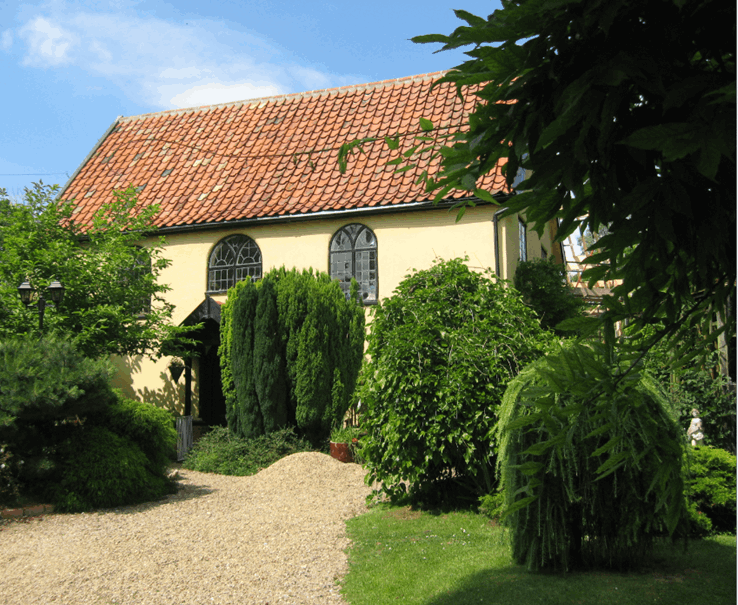
The History of Our Village Through Time
Written by Stewart Robertson

Hapton Chapel is a mid-18th century Grade II-listed Dissenters’ chapel. The building is rendered with a pantile roof that has gabled ends. There are three round-headed windows with gothic lights and leaded panes to the front. The main entrance is by a round-headed doorway within a Victorian wooden gabled porch. The interior was converted to a dwelling in 1976 and the building extended in 2016.
TIMELINE
1645: First reference is made to a congregation of Dissenters at Hapton when the “Church Book of the Independent Congregation” at Yarmouth records a letter asking
advice about the Lord’s Supper.
1647: Oliver Cromwell, then the most powerful man in England, writes to Thomas Knyvett, a Royalist landlord, asking him to protect “certain poor men of Hapton” from
persecution because of their religious beliefs.
c. 1700 George Gay, a brewer, establishes a meeting-house for Dissenters at Long Stratton, appointing Rev. Robert Chaplin as minister. Chaplin also officiates at Gay’s
house in Hapton.
1729: Elizabeth Gay – the widow of George or his son, Roger – wills her property in Hapton in trust for the erection of a meeting-house and the maintenance of a minister
to conduct services. The trust deed states that the meeting-house is to be for Dissenters from the Church of England, either Presbyterians or Congregationalists. The first
minister is to be Robert Chaplin. He is to live rent-free at Elizabeth Gay’s house (now Hapton House) which, after her death, is to become the parsonage. Chaplin’s stipend is
to be paid out of the rent from Mrs. Gay’s property of 113 acres of farmland.
1741: Elizabeth Gay dies.
1749: Start is made on the Hapton meeting house: clay lump, with timber brought from a disused meeting-house in New Buckingham and with brick chimneys.
1751: Robert Chaplin preaches the first sermon at the new Hapton Chapel.
1836 – 1856: Rev. William Selby plants various trees in the garden, several of which still stand.
1856 - 1902: Rev. James Knapton becomes Hapton Chapel’s longest-serving minister.
1903 – 1917: Rev. A. E. Rump (from Norwich Octagon Chapel) undertakes thorough repair of the chapel and parsonage.
1928: The Charity Commission gives permission to sell the parsonage and the land to provide for maintenance of the chapel and its services. Decision is made to have
shared ministry with the Octagon Chapel (rather than appoint a resident minister at Hapton).
1930: Rev. J.K. Nettlefold – the first of a series of ministers who conducted services in Norwich and Hapton – writes his pamphlet history of the chapel. Nettlefold
concludes that “the future seems to promise a long life of religious usefulness to Hapton Chapel”.
1960: The Charity Commission gives permission to sell the chapel due to changing economic circumstances, an aging congregation and dwindling funds.
1976: Hapton Chapel is converted into a house, previous to it lying empty for a number of years and being in a ruinous state.
1981: Historic England gives Hapton Chapel Grade II-listed status.


We make every effort to document our research. If you have something you would like to add, please contact us.